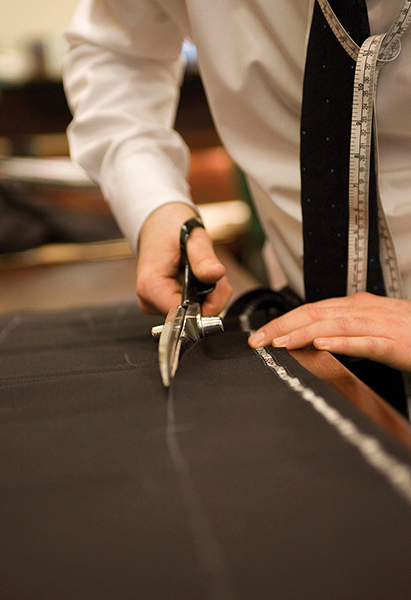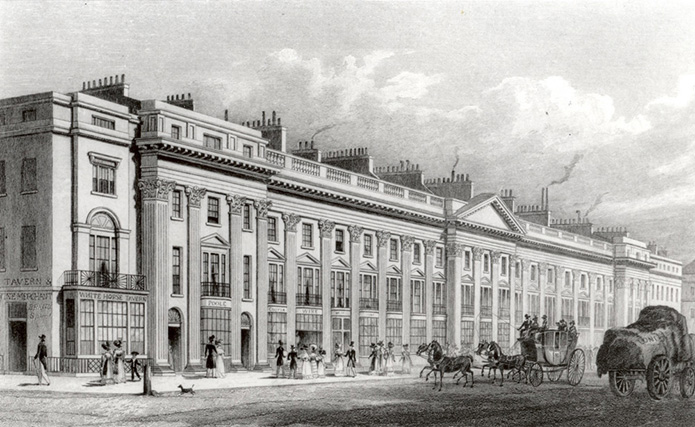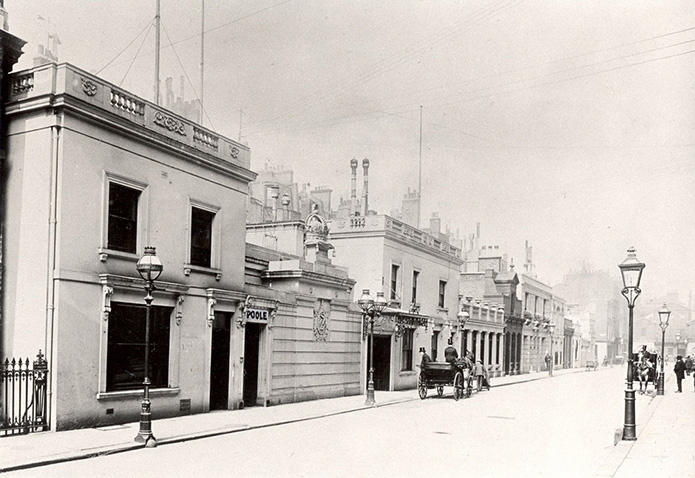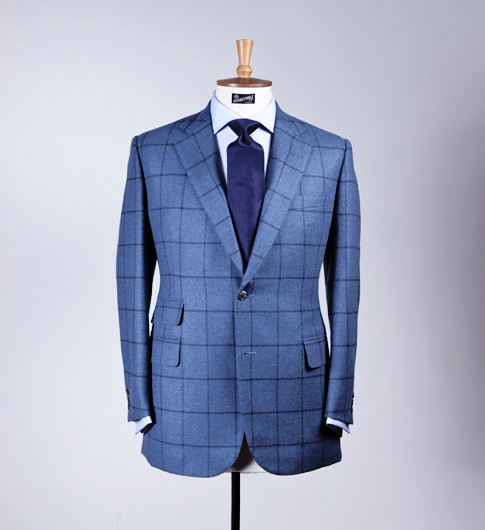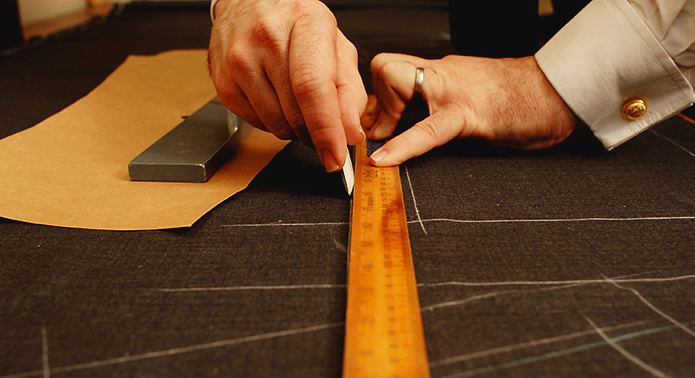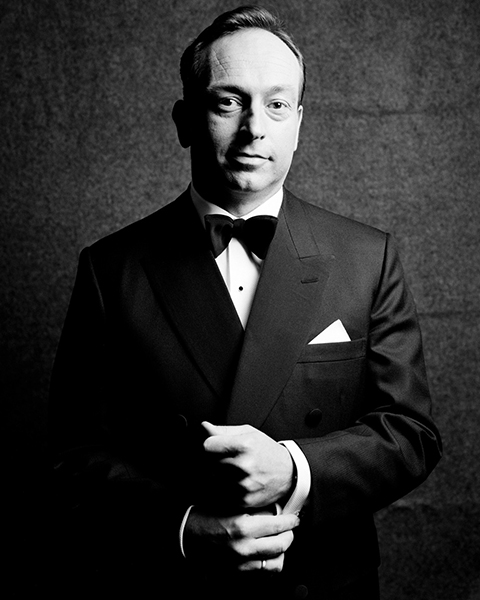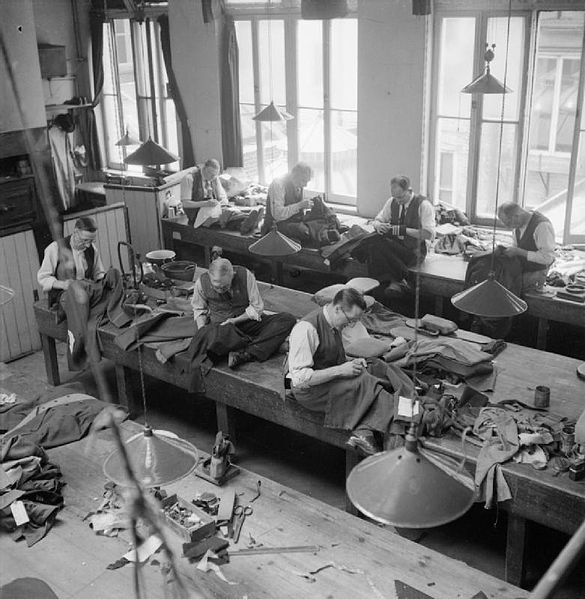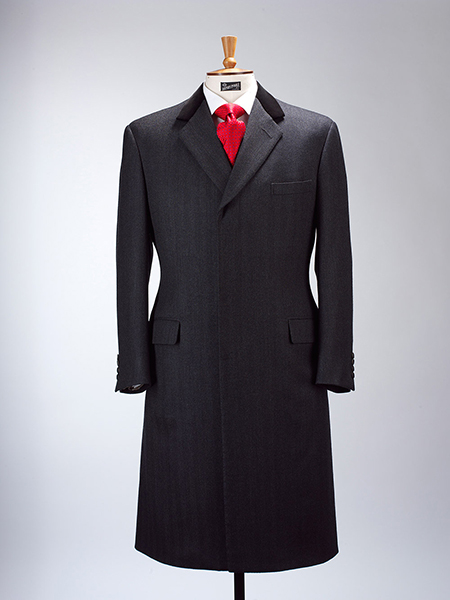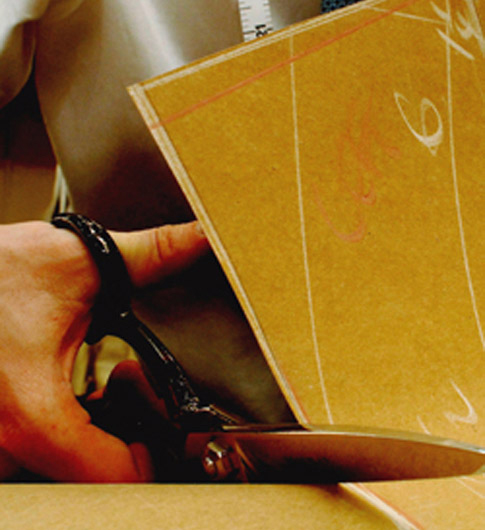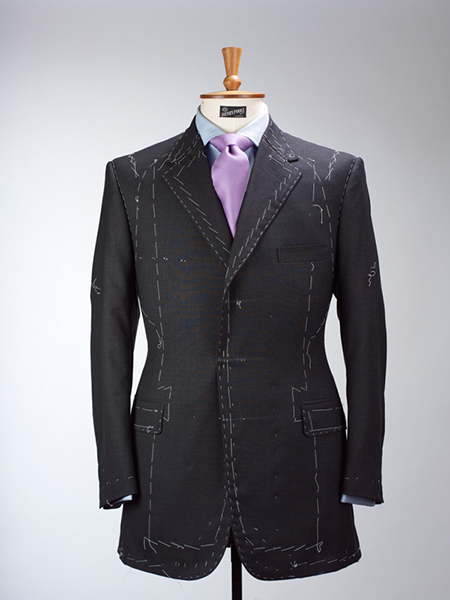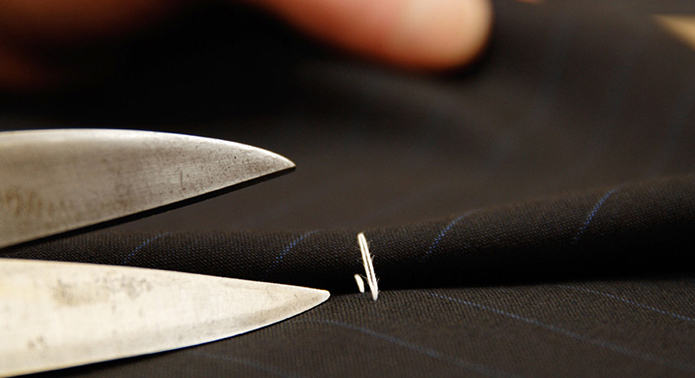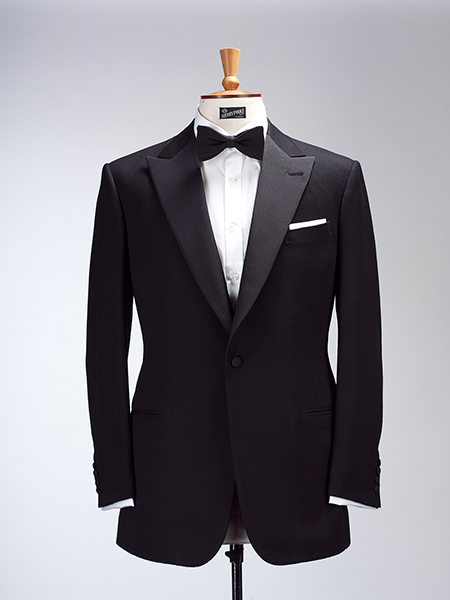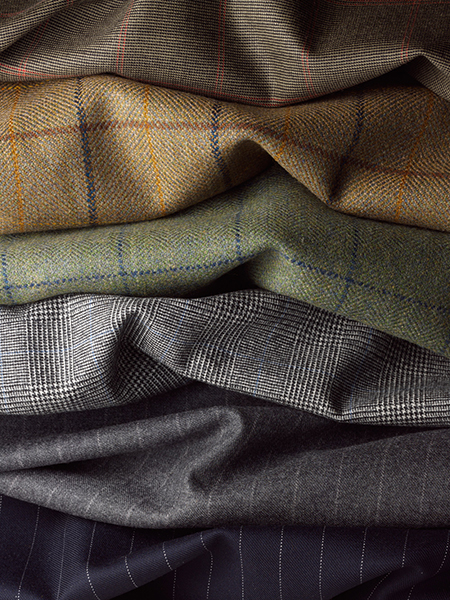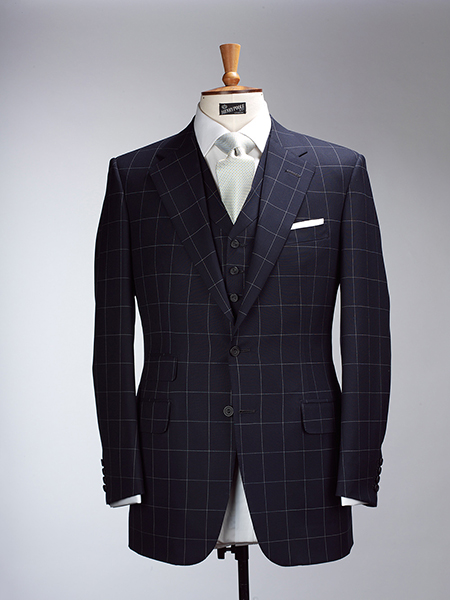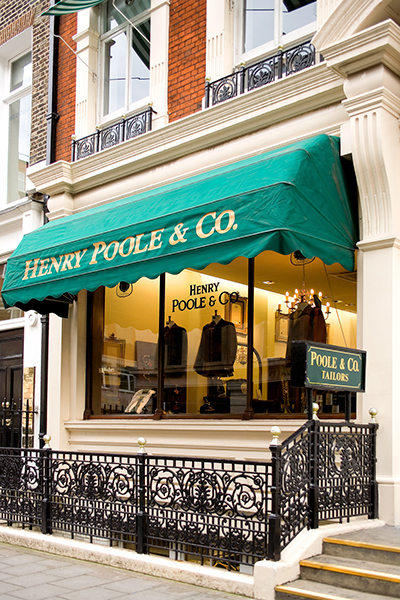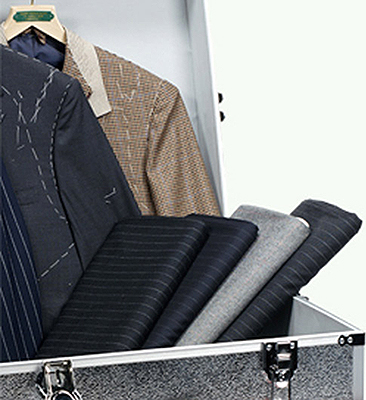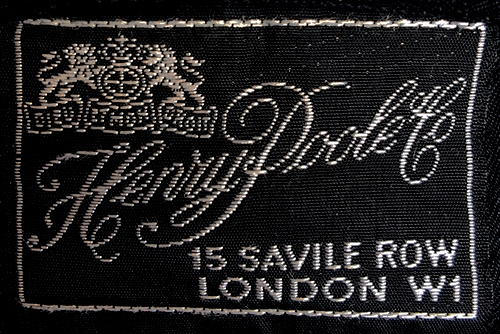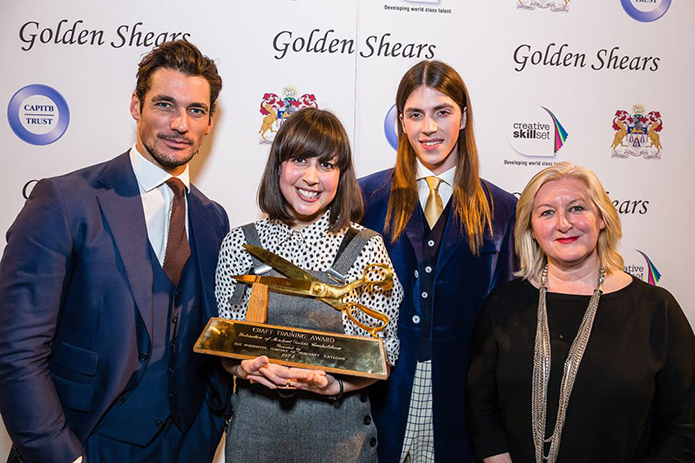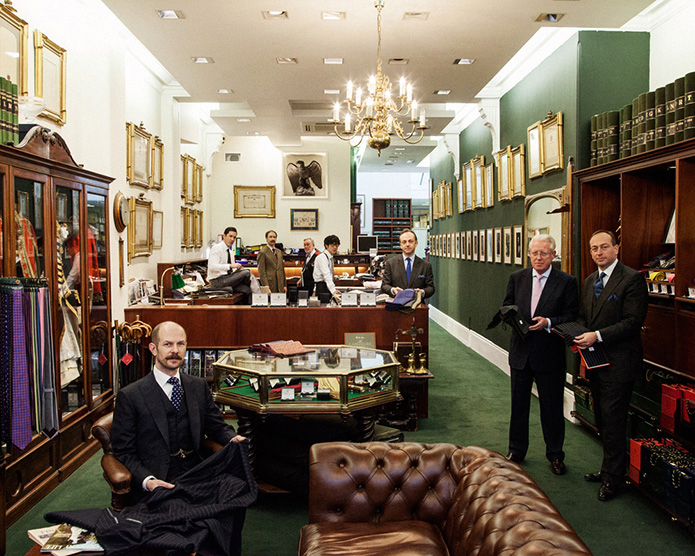
Situated in the heart of Mayfair, sartorial Savile Row, a short yet iconic street, often shortened by those in the know to simply ‘The Row’, is a prestigious trading address that has seen over 200 years of society gentleman’s tailoring. Originally a street of highly esteemed military and politician residents, and a popular area within the medical profession, then, in 1846, Henry Poole opened up the back entrance of the family’s Old Burlington Street shop to expand their second-generation, already flourishing tailoring trade, into what would become the world-renowned Savile Row.
This was a crucial turn of events that converted the area from medical stitchers (the doctors migrated to Harley Street, by the way), to merchant stitchers of the atelier profession, and Henry Poole & Co is recognised as the founding father of that world-famous ‘golden-mile’ of society tailoring, as many other high-end tailors followed their lead. Savile Row is where the great and the good of the age, from the mid 19th Century to the present day, royalty, statesmen, gentry, businessmen and celebrity, travel to be measured up for a suit that is ‘spoken for’ by an individual customer, handcrafted from a single cloth, without the use of any pre-existing pattern, which gave rise to the term ‘bespoke’, something made specifically for an individual and that individual alone.
Henry Poole & Co is the epitome of the quintessential English gentleman; classic, solid and timeless. It the oldest and largest establishment on The Row, with thirty in-house tailors, maintaining the trusted and discreet relationship between a gentleman and his tailor; be that gentleman; a country gent or city corporate; from the states-room to the stage. Today, co-owners, Simon Cundey, and his father Angus, direct descendants of cousins of the Pooles, continue to steadily steer Henry Poole & Co through the 21st Century, and Simon had kindly given up some of his precious time to allow us an insight into this world famous world of sartorial high society.
Firstly, for those readers who aren’t familiar with Henry Poole & Co, please can you tell us about the history of the company?
Henry Poole & Co is the founding father of Savile Row, as The Row itself didn’t even exist when James Poole, Henry Poole’s father, established the company in 1806. Of course, there were other tailors in the vicinity around Hanover Square and St James, but not in Savile Row itself. James was originally a cloth merchant who became a military tailor.
When he died in 1846, Henry inherited the firm and set himself up as a tailor for private individuals, including famous names such as Sir Henry Irving and Charles Dickens, amongst others. He was spotted by Prince Louis Bonaparte in 1846, nephew and heir of Napoleon I, who was living in exile in London at that time, who asked Henry to become his tailor; when Prince Louis became Emperor Napoleon III he bestowed him with his first Royal Warrant in 1858. In 1860, through royal connections, the Prince of Wales, later King Edward VII, commissioned Henry to create a smoking jacket for him to wear at informal dinner parties at Sandringham, and he gave us our second royal warrant in 1863.
Through the connections he was making at the time, particularly amongst royalty, pretty much anyone who was anyone coming through London also commissioned Henry Poole to create a suit for them, especially so for popular sporting occasions such as hunting, shooting and horse racing. Within a very short space of time Henry went from having no warrants at all to fifty, and crowned heads were coming to him from as far afield as France, Germany and Italy. Henry was known as the ‘tailor of Europe’ – a celebrity tailor – as no other tailor had such privileged access to high society parties and royalty as him. As a measure of his stature, when he started his career he was just a humble tailor, and upon his death various letters were read out from Kings and royalty throughout Europe which is pretty amazing. By the end of the 19th Century the firm employed as many as 300 tailors!
When Henry inherited the firm in 1846, the premises they were working from actually fronted onto Old Burlington Street, and it was the rear entrance of the building that fronted Savile Row (which was in fact a parking point for visitors to Regent Street). Henry enlarged the premises and built a palatial showroom as well as expanding the rear entrance of the building, which actually became the main entrance. This is why Henry Poole & Co is known as the founding father of Savile Row.
I am actually the seventh generation in my family to own the company. Henry didn’t have any children, and so when he died he left the business to his cousin, Samuel Cundey, who was also working in the business at the time. From there, it has been passed down the line through five further generations with the Cundey name.
Is there a particular ethos or style that you are noted for?
Our ethos, both past and present, is that we are not dictated by fashion. We adhere to balance of posture, size of build, and proportion of figuration (the way you stand, shoulder slope etc), and the key consideration for us is balance in proportion to stature and figure of the individual, and not passing fashions. Whilst we don’t ignore fashion, we are not driven by it.
What advice would you give to someone who is considering purchasing a bespoke suit on Savile Row for the first time and is feeling a little intimidated and daunted by the process, in terms of maybe not knowing what fabric to choose, understanding the different cuts etc?
Doing homework prior to meeting is very important. You really need to decide if you want a pure bespoke suit (custom made specially for you, where the suit is measured, cut and put together all in the same premises), or a bespoke suit (where the suit is measured and possibly cut in one location, but then sent away to be cut and/or put together in another location) or possibly made-to-measure, where the suit is made in a factory based on perhaps only a dozen key measurements inputted into a computer and you are presented with something that is the nearest size to you, but doesn’t cater for things such as where one shoulder is lower than the other, and other problems like that.
I would certainly recommend someone considering purchasing a Savile Row suit to look on the website of the tailor they are considering using, and see what they’re about, to ensure they are comfortable with the level of service they can provide.
During the initial consultation, you really need to be comfortable with the cutter you are talking to, in the same way as you need to feel comfortable with your doctor or dentist. Ask as many questions as possible. The cutter will talk through the three key stages in creating a pure bespoke suit, and hopefully demystify the process for them. The customer can also see various examples of garments, and get a feel for the many different types of fabrics, styles and weights; the latter being very important to the practicality of the suit.
The cutter who you will be talking to really needs to understand the practicalities and purpose of the suit, so the more information you can give them, the better, and they are very experienced in interpreting this into providing suggestions and ideas for you to consider. For instance, if you are explaining that you are looking for an evening suit, they will explain that a softer material would be recommended, as evening suits are touched more intimately during the course of an evening, whereas if the suit is for a businessman who travels a lot, then the cutter would recommend harder fabrics, which would be able to hold a crease. Remember, the customer is the ambassador for what the cutter is selling, so it’s important that the cutter gets it right!
You are the seventh generation in your family to run Henry Poole & Co. Was it a foregone conclusion at an early age that you would take over the family business?
As a child I would often help out my father working in the packing department, helping to send suits to destinations throughout the world, but I can’t honestly say I knew it was my destiny at the time. It wasn’t actually until I was about 16 or 17 years old that I knew for certain that I wanted to work in the family business; the catalyst came when I started working at the luxury Italian shoe store – Salvatore Ferragamo – in Bond Street during school holidays, and I found it really busy and exciting, providing a high-end service to very wealthy clients, many of whose husbands, it turned out, were also clients of Henry Poole & Co. It was there that I got to know the service industry and clients’ tastes and likes.
However, to work in the family business, I really needed to learn the industry, and after school I went to the College of Fashion to undertake a three year Diploma, and from there did an apprenticeship at textile mill Taylor and Lodge in Huddersfield which had an excellent reputation for crafting worsted cloth – in fact I still do business with them today! It was there where I learnt my knowledge of weaving and understand of finishing skills which I can express to clients, explaining the qualities and problems associated with different types of fabrics. I think having that outside experience has been tremendously beneficial, to really understand all realms of the industry.
What do you think are the main contributing factors as to why the Henry Poole & Co brand has endured for so long, faced with such competition and change in the industry, particularly in recent decades?
There’s no doubt that the industry has faced some great dilemmas – wartime, globalisation, economic change and changing fashions. For instance, at one time, livery costumes for servants within households were a key part of our business, but this is less in demand now. Likewise military tailoring was also very important once, but this department closed down after the end of World War One. So we have had to adapt to change, and will continue to do so.
I think the main factors as to why are brand has endured for so long are that the suits we make are the epitome of the British suit; and we enjoy a reputation for creating a classically designed and proportioned suit, that can last for decades.
Henry Poole & Co’s notion of apprenticeship for the next generation is also key. Any tailor worries about the next generation of customer, and fears bad news in the obituary column in The Times of one of their customers passing. Likewise, customers are also concerned when the wonderful cutter they have worked with for many years eventually retires. So, it’s important for us to ensure continuity in the firm by making available apprenticeship schemes for future cutters for all departments, learning from their more experienced colleagues, so that customers can be assured that they will continue to be provided with the same level of service in future years and the skills aren’t lost.
What makes a pure bespoke suit so special, compared to, say, semi-bespoke?
Pure bespoke is made entirely for you. Thirty different measurements are taken all over the body to ensure the balance of the coat and your size and posture are a perfect match. For example, with a pure bespoke suit we can provide a high armhole which gives your arms increased movement without the jacket riding up when you reach out for something, and we can deal with creasology matters to ensure the centre line of trouser creases are in the dead centre of each trouser leg, taking into consideration whether someone is slightly knock kneed, bowlegged or one hip is slightly higher than the other; all causes of creases not being in the dead centre. All the finer details are spotted by us and we deal with them.
Historically, your client base includes royalty, the aristocracy and world leaders. Is there a typical Henry Poole & Co customer today, and if so, how would you describe them?
Whilst we still do have royal clients, most customers today are from the business community, such as CFOs and CEOs of companies, or people working in financial houses and legal and accountancy professional services firms. These people have lifestyles that mean they want a suit to provide consistent comfort and to be able to dress consistently in the same way. They don’t want any dragging or tightening of the suit, and they want to look right in what they wear. After all, they are very discerning people. They want the kudos of having a Savile Row suit, and the majority of them have come to Henry Poole & Co as recommendations from other customers.
Could you briefly guide us through the design and production process for one of your pure bespoke suits?
Upon meeting a future customer, the first thing we discuss is the purpose of the suit – its needs and use. We then show different fabrics, and explain how the different fabrics perform. To get a feel for the different weights, the customer will try on different suits of varying fabric weights. Then we go through the suit style, and discuss detailing that the customer may want to build in, such as custom-made interior and exterior pockets catering for such items as wallets, phones and notepads, depending on their bespoke requirements. The cutter will then take the customer’s measurements and cut a paper pattern based on these measurements. The cutter will then lay out the pattern on the choice of cloth and cut out the pattern by hand. A highly skilled tailor will then put the suit together ready for the first fitting.
Three weeks after the first meeting, the customer will come in for the first fitting, whereby the cutter will make alterations to the suit, taking into consideration the customer’s posture, how they stand and overall balance. For example, if the customer has sloping (bottle) shoulders, the cutter would give extra padding, or if the customer is short-legged, the cutter would cut the coat slightly shorter, by perhaps three quarters of an inch, providing a longer-legged look and ensuring the eye-line goes to the legs rather than the jacket, resulting in a better proportion of figuration of legs in relation to the torso. The suit will then be taken apart by the cutter, re-cut, and then handed back to the tailor to be put together again.
In another three weeks the customer will come back for a second fitting, during which alterations and amendments from the previous fitting are refined, and checked for shape and drape. Two weeks later the customer will come back for a third fitting for hand finishing, such as making button holes by hand and other hand finishes inside and out. The suit is then ready for a final fitting, and advice is given to the customer on how to look after the suit and how to maintain its shape. The suit is then numbered and logged, which we can refer to if repairs need to be made. We also keep the paper patterns of body, which we can refer to for any subsequent suits. In total, it’s approximately a 2 month process from start to finish.
For any subsequent suits made, the timescale is much shorter, as we know 90% of the information already from previous meetings, even if they took place many years ago. The human posture doesn’t change much in five years, and height doesn’t normally change for forty years, so it’s only really the smaller details, like the waist, that varies in a short timeframe, and we can include extra material in the seams to maintain the balance if the client has put on weight. For subsequent suits, we will send out pattern and fabric swatches to the customer’s home based on what they’ve explained they want, either over the phone or in the shop. Generally, all we really need is one fitting and the suit is ready to take away or for dispatch.
Why do you think that Savile Row tailors generally, and Henry Poole & Co in particular, are so well received in overseas markets?
The British ‘cut’ is really the epitome of masculinity and a structured suit which is popular throughout the world. Of course, Paris, Rome and Napoli all have their own look, which are sometimes a little bit more flamboyant, and in Napoli especially, they have a much softer tailoring style, but the elegance and persona of sharpness really comes across with Savile Row suits. That has always been the case with Savile Row, and I don’t think we have digressed too much from that.
The other things is people know that Savile Row suits are built to last, and some of our clients still wear suits from 50 years ago. Tweed suits can last a lifetime. For a father-and-son relationship, it’s akin to inheriting a Patek Philippe watch where it can be passed down from one generation to another.
Typically a customer that follows Savile Row will choose one house in particular for all their suits, or they may choose one house for one type of suit, and then another house for another type of suit. For a global player of clothes, a customer may choose Savile Row suits most of the time, but then for the summer heat, they might choose a soft summer sports jacket from Napoli, which fits a little looser and is a lighter weight than ours. It may not necessarily be the most elegant of cuts, but it may serve a purpose.
How important is the quality of fabric in creating a pure bespoke suit and do you only source fabric from the British Isles?
The quality of the fabric is very important, and we look to fibres to be durable and luxurious. The fabrics we source have to be consistent and manufactured to the same high quality year-in and year-out, so quality control is very much involved. This consistency is beneficial if, for example, a customer has an accident and rips the suit – our cloth merchants often have the same design and finish available in stock enabling us to make repairs.
The majority of our fabric is British, probably as much as 80%, with the remaining 20% being Italian. Generally speaking, British cloth has more of a matt finish, with less sheen to it – the shiny look is not that popular in Britain, as it gives the impression of being ‘worn’. Italian cloth is generally more flamboyant, and has more inspiring blends than in the UK.
Do you think the younger generation today still has an appreciation for traditional tailoring and investing in quality over quantity?
I certainly think so. In my experience, the younger generation today are very discerning, and seem to be shunning the notion of ‘designer labels’, and looking at quality over quantity. Young people come to a point in their life when they want to try different things, and this is no different to when they choose clothes. They try things out, purchase something they like, and then after a while, when finances allow, elevate to the next stage and then find a point they are happy with and a balance where they want to be. Often some people will elevate their choice to a pure bespoke suit and have their own design made for them. They know the good things in life aren’t cheap and they must be patient to afford one, but they view them as special and are really appreciative when they finally take hold of one of our suits. This is definitely still as true today as it ever has been.
How important is it for tailors to be based around Savile Row today, and do you feel the encroaching mass-market retailers on the historical street could be a catalyst for impending change?
We’re very lucky in Britain to have one street dedicated to gentleman’s tailoring, and there’s nowhere in France, Germany or Italy quite like it. Without the kudos of being on one street, I would imagine we would lose 10% of our business. So whilst we’re always aware of the competition, we actually embrace having neighbouring competitors. In fact the prestige of the entire St. James and W1 areas is important for us, whether it is for gentlemen buying shirts, shoes, wine and cigars – having an area famed for luxury gentleman’s stores, and maintaining this level, is very important.
The opening of the Abercrombie Kids store, by Abercrombie & Fitch, has obviously caused a stir, as they’re not men’s tailoring – their products are aimed at children – and the overwhelming feeling is that we don’t want high street stores on Savile Row. We welcome one-offs, such as Lanvin, provided they are for gentleman, and that could be overseas companies, or British, but they need to have a menswear origin. We believe Westminster council and landlords feel the same way as us. Whilst major groups can afford to pay higher rents, the consensus is that the wrong stores will adversely affect the character and balance of the street, which wouldn’t be in the long-term interests of most.
How do you foresee the future for Henry Poole & Co; for instance, are you planning on opening overseas stores, and would you consider Made To Measure or Ready To Wear at any point?
In London, we will maintain our focus on pure bespoke suits, as that is what we specialise in here. We will continue to be represented in overseas countries, such as the USA, France, Germany, Switzerland and Japan, through regular Trunk Shows whereby we take fabrics with us in trunks to overseas hotels which customers can try on and our cutters can take measurements and carryout various fittings, which we will work on back in Savile Row, and then take them out again in future Trunk Shows for customers to try on. This works very well for us for overseas customers who want a pure bespoke Savile Row suit but don’t have the ability to travel to the UK for the various fittings.
With regards to store openings, we do have four overseas stores already, in Japan, where we have formed a partnership with Onward Kashiyama, to provide a complete range of Made To Measure garments, and we have also opened two Henry Poole & Co shops in Beijing and Hangjou in China, which we opened in 2006, also offering a Made To Measure service. For all four overseas stores, our cutters travel out to the stores to provide local staff with expert training, and we also supply them with our British fabrics, although the garments include a modified label – so instead of our signature house label – the Kings Arms – which is inserted into suits that are made in our London shop, the items made overseas include the Napoleonic imperial eagle, reminding customers of our heritage, but differentiating the brand between those items made in the London and overseas. This works well for customers who want the Henry Poole & Co brand, but can’t quite afford a pure bespoke suit.
Finally, what advice would you give to anyone considering a career on Savile Row?
Don’t leave it too late. Certainly, the younger an individual is, the more adaptable they are, and they will generally pick things up quicker than someone who is much older who is having a career change and going back to learn. Often a cutter can start travelling the world in their mid-20s, if they started when they were 18, so the younger you start, the better exposure you can get at an early age, and of course with Savile Row, you have a unique opportunity to meet wonderful customers and visit countries where they come from.
You do, however, need to be sure that it’s the right career for you. Whilst tailoring is about mathematics and artistry (technical drawing is very important), you also need to have a good eye. Tailoring is constantly evolving and you need to apply different matrixes to different styles and fabrics. Skill-wise, you need to have a good motion in the way you sew and cut, and it’s easy to spot someone who has got a natural flowing rhythm.
Always ask questions when you start out in your career; ask why something is done in a particular way, as it’s obviously done for a reason.
As to the merits of apprenticeships versus college course, I’d say that apprenticeships, in my opinion, can be a quicker route. If your heart is really in Savile Row, then it’s best to jump in. College courses give students a rounder approach, and after leaving you are more flexible in terms of choice of career (having worked with machinery, using CAD patterns etc), but I think it leads you to a career in industry working with the big manufacturing houses like Gucci and Hugo Boss, whereas in Savile Row, you are really learning a craft.
Thanks to Simon Cundey for taking time out of his busy schedule to answer our questions. All images © Henry Poole & Co, with the exception of historic tailoring image from 1944, which is copyright of Imperial War Museum.

